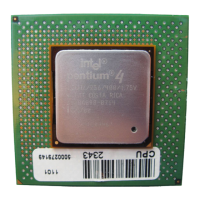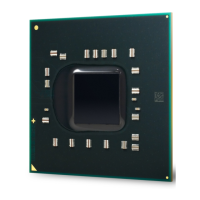Intel386™ EX EMBEDDED MICROPROCESSOR USER’S MANUAL
7-12
Figure 7-7. HALT During SMM Handler
7.3.3.3 Idle Mode and Powerdown Mode During SMM
Both Idle Mode and Powerdown Mode may be used while in SMM. Entering and exiting either
of these power management modes from SMM is identical to entering or exiting from normal
mode. The interaction between SMM and power management modes is described in Chapter 8.
7.3.3.4 SMI# During SMM Operation
If the SMI# request is asserted during SMM operation, the second SMI# cannot nest the currently
executing SMM. The second SMI# request is latched, and held pending by the CPU. Only one
SMI# request can be pending. After RSM execution is completed, the pending SMI# is serviced.
At this time, SMIACT# is deasserted once at completion of RSM, then asserted again for the sec-
ond SMI#.
When the SMM handler polls the various SMI# sources for one of the SMI# triggers, and two
SMI# sources are found in the SMI# generation circuit, the SMM handler services both SMI#
sources and executes a RSM instruction. In this SMM handler, if the SMI# generation circuit as-
serts the second SMI# during the first SMI# service routine, the second SMI# is pending. Next,
the SMM handler finds and services two SMI# sources. After the CPU completes the RSM exe-
cution, the pending SMI# (second SMI#) is generated, but there is nothing to service because the
second SMI# was serviced during the first SMM handler. This unnecessary SMI# transaction re-
quires a few hundred clocks. There may be some performance degradation if this example occurs
frequently. For good performance, it is the responsibility of the SMI# generation circuitry to man-
age multiple SMI# assertions.
7.3.4 SMRAM Programming
7.3.4.1 Chip-select Unit Support for SMRAM
The internal chip-select unit (CSU) has been extended to support the SMRAM by using bit 10 in
each Low Address (CASMM) and Low Mask register (CMSMM). The CSU acts on these bits
A2507-01
State
Save
SMI#
SMM
Handler
Instr
Instr
Enable
INTR & NMI
HALT Halted
State
SMM
Handler
State
Resume
Instr Instr
Interrupt
Handler
INTR or NMI
#1 #2
#3 #4

